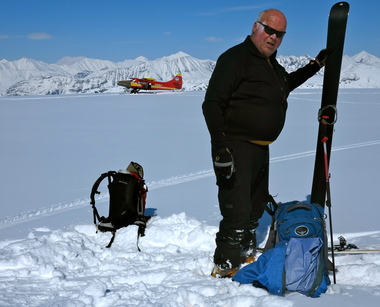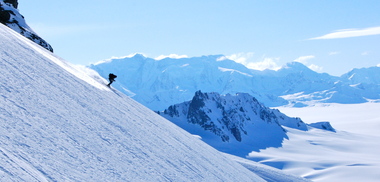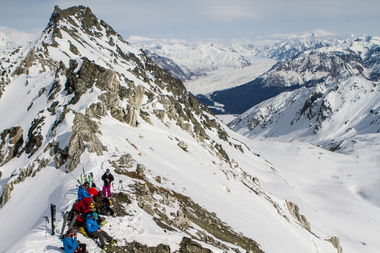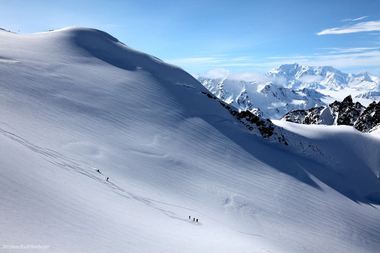Meet Sorhrab Gollogely, an Alaskan born orthopedic surgeon now living in Californian and discover his passion for backcountry ski touring in the Wrangell/St. Elias Mountain Kingdom.
Find out what brings Sorhrab and friends back to Ultima Thule year after year and why he says “You’ll never enjoy skiing more.”
(The author along with Hedric and Hansi Hanson enjoying the crowning moments of a perfect day)
For the past 3 years I've been making an annual pilgrimage to the shrine of late season Alaska powder skiing at Ultima Thule Lodge in the Wrangell/St Elias National Park. I live in coastal California so this trip typically occurs well after the season has shut down for good in the lower 48, and often after we've had our first south swell of the year to mark the beginnings of summer. The itinerary typically looks something like this…fly to Anchorage International, arriving late in the evening for those of us stuck in some modern version of slave labor on the west coast. Rent a car and drive to Chitina the next day. It's a five hour, 250 mile drive, and the trip is like passing through an airlock on the way to a different part of the planet. The Glenn Highway leaves the temperate coastal climate of Anchorage and follows the Matanuska river towards its glacial origins, crossing the northern reaches of the Chugach on the way to Summit Lake, and then descends on the other side of the watershed towards Glennallen where a right turn takes you down the Richardson highway towards Valdez. Fifty miles short of the ski touring mecca - Thompson Pass you take a left on the Edgerton Highway, ducking underneath the rope and avoiding the rotor bladed scrum of heli assisted skiing in Valdez. The Chitina airport is a 2,850' gravel strip on a bench just above the confluence of the Chitina and Copper rivers and its here that you finally push off. It’s a 45 minute flight in Ultima Thule's Otter or the 185 to the lodge, and its only after you arrive that you get a sense of exactly how far off the beaten path you are, and just how much terrain there is out there -- always untracked, often unexplored, and waiting patiently for someone with the right tools, a good set of lungs, and some strong quads.
The national park service regulates recreational activity in the Wrangell St Elias national park. Their policy states that "Fixed wing aircraft landings are allowed in the park. Helicopter landings and airdrops are prohibited." What this means to you is that you are not going to get a Heli bump to the top of 55 degree couloir that you can drop sight unseen, but you will get a super cub or a turbine otter ride to a glacial plateau surrounded by countless chutes, slopes, and aspects that you can ski as long as you can climb. I personally love ski mountaineering. The equipment has improved so much over the last 10 years that it’s not like driving an old boat of a car the way it used to be, swaying around the corners and splashing through the curves on dubious suspension with poor steering response. I ski Dynafit bindings and Scarpa boots. The bindings work nearly flawlessly in nearly all snow conditions -- from bone dry 10 degree below zero fluff to gritty frozen chicken heads. They have 3 levels of heel lifters for the way up and solid DIN release mechanisms for the way down. Right out of the box Scarpas fit and feel like a pair of loafers until you buckle them down, flip the ski/walk mechanism to ski, and tighten the booster straps. At that point they feel pretty close to a frozen hardshell alpine race boot. At least close enough for powder skiing.
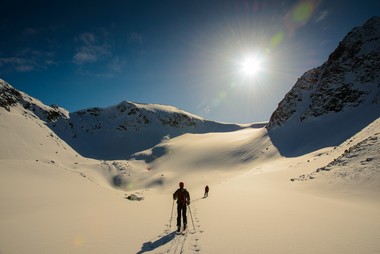
I spent 5 years in Salt Lake City. It was towards the end of those five years that I finally left the lifts of Alta on the south side of the road and hiked up the flanks of Mount Superior and figured out what so many others already knew: the skiing is way better if you climb it yourself. I wasn't alone, since it was also during those years that backcountry skiing really started to explode. I'd guess that Andrew McClean shares some of the blame for opening up the Wasatch backcountry to casual users. There's nothing like a guide book, especially one called The Chuting Gallery -- a guide to steep skiing in the Wasatch Mountains, to turn secret stashes into buffet lines, but the end result is going to be positive in the end. The more people discover that skiing doesn't require resorts, the more we'll have a dedicated cadre of backcountry skiers to advocate for access, protection, and recognition of the fact that the mountains are best left wild. Tracks fill in with the next snowfall but lift towers are forever.
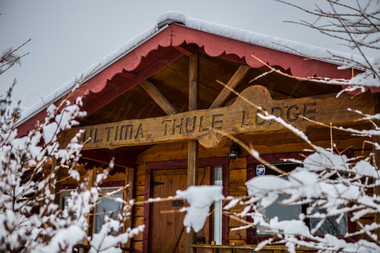
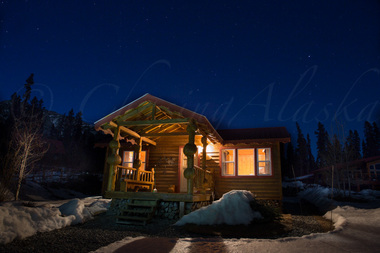
For the last three years at Ultima Thule we've had solid conditions. It seems like the running average is about 5 bluebird days in a 7 or 8 day trip in late spring, with a couple of days of overcast or low weather to allow you to rinse off the sweat in the sauna, do a bit of ice climbing, catch up on your reading, or go out for a cross country ski on the river. The lodge is on the backside of the Wrangell massif and as a result the area enjoys a lot more sun and good flying conditions than Cordova, Thompson Pass, or other coastal points south. For the last three years I've also been fortunate enough to enjoy the company of one of Ultima Thule's faithful clients - Hedric Hanson. Hedric lives and works in Anchorage and after fortuitously delivering the first of Paul and Donna’s kids in his capacity as an obstetrician, he was invited out to Ultima Thule 25 + years ago in a uniquely Alaskan gesture of thanks. As in, "Thanks for delivering our child, now come out to our homestead and ski with us." I don't think he ever looked back. He hasn't made it through a winter since without trekking out to the Wrangells for an early April ski trip.
Hedric has personally witnessed most of the changes that have elevated the spring skiing game at Ultima Thule. Reudi "Hombi" Homberger added his Swiss snow sense and avalanche awareness to the Alaskan knowledge base in the early years. The turbine otter arrived in 1996, making higher altitudes more and more accessible. The combined bushing flying talents of Paul, Jay, Ben and their companions opened up more and more terrain over the years, and the later arrival of ink worthy athletes like Jeremy Jones, Andrew McClean, and other underground backcountry ski mountaineers cemented Ultima Thule's stature as a hidden gem. Completely off the beaten path, and only for those willing to work for their turns.
I like skiing with Hedric because Hedric knows what it's all about. He's got a heart of gold, and legs that run on diesel. He's been backcountry skiing for 30+ years and you'll never see anyone enjoy themselves as much as he does. In a world of instant gratification and ever escalating standards for extreme sports, it’s good for your soul to spend time with someone who acts like a kid when he's seventy years old.

Ski mountaineering and backcountry touring is enjoying a bit of a moment right now. Sort of the way that big wave paddle surfers are also enjoying a well-deserved moment of recognition. Gushing enthusiasm over the exploits of tow surfers and heli-skiers has gradually given way to the recognition that the machine was what is really providing the magic. Put a surfer on the back of a rope and you take the crucial variables of positioning in the ocean, wave selection, and paddle power out of his hands and give it to the driver. Put a skier in the back of a helicopter and you'll never find out how good his (or her) quads really are, what the snow looks like on the way up, and whether or not they are really someone that you want to share a beer with at the end of the day. If you pay attention to Paul Claus, you are also breaking one of the cardinal rules of being in the mountains the moment you climb out onto a ridgeline obscured by rotor wash -- never ski something you haven't climbed -- because you'll never really know what the avalanche danger is until you are fully committed.
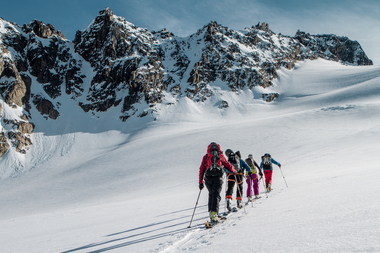
Ultima Thule is off the grid. Food is gathered locally or shipped 350 miles, electricity is made on site, and water comes from the river. When the generator goes off at 10pm, its really quiet. When it clicks on a 7am, you've just gotten one of the best nights sleep on the planet. Coffee and breakfast is one the table around 8:30, and usually by 9:30 or 10 the crew is assembling at the airfield. Paul's got access to an area twice the size of Rhode Island with mountains that make the Alps look like foothills, and it’s not uncommon to drop into a breathtaking valley and have paul shrug his shoulders as the turbine winds down and say, "I don't think anyone has ever skied in here before." Ever. Most days, it’s not really clear where we are skiing until we've been in the air for 20 or 30 minutes and Paul and Hombi have gotten some sense of where the snow is laying dry, stable, and out of the wind. If the conditions are right, Paul usually drops us on a glacial plateau, 6,500 or 7,500 feet above sea level. His sweet spot is a thousand yards of reasonably flat snow, with a peak above, and a long run to valley floor below. This gives us the chance to start the day climbing. Skins on, shells in the pack, a handful of nuts and a sip of water, and you get to settle into the rhythm of going up. I love it. I get to clear my head, focus on my breathing, notice all the tiny little details that will just slide right by if you're not paying attention. Going up gives you the opportunity to ski it in your mind first, and since a big part of being in the mountains is the “being” part, slow down and enjoy.


